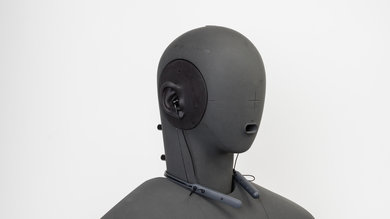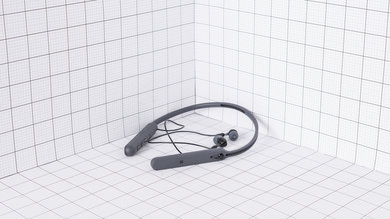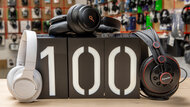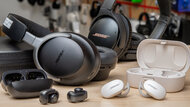Our Verdict
Average for mixed usage. The Sony WI-C400 have a decently comfortable and lightweight design that's stable enough to run with. They also have a long battery life for continuous use. Unfortunately, they have a mediocre-at-best sound quality. They do not isolate as well as other in-ears and take a long time to charge. They also have quite a bit of latency which is not suitable for gaming or watching a lot of videos.
- Lightweight and stable design.
- Low leakage.
- Long battery life.
- Poor noise isolation.
- Mediocre-at-best and slightly piercing sound.
- High latency.
Mediocre for neutral listening. They have a good mid-range but can sound a bit too forward and piercing on already bright tracks. They also have a lackluster bass range that's missing a lot of thump and rumble so they may sound a bit bland and boring to some. Unfortunately, they are closed-back in-ears so they can't create a spacious and open soundstage which won't be ideal for neutral listeners.
Average for commuting. The Sony WI-C400 do not block a lot of noise but they're decently portable, comfortable and fairly easy to use. You can also mask some of the ambient chatter of your commute by raising the volume level since they barely leak.
Above-average for sports. The WI-C400 are easy-to-use and have an around-the-neck, in-ear design that's stable enough for running. They're also lightweight, decently portable, and wireless. However, the in-ear tips do slide a bit in the ear canal during more strenuous activities.
Average for office use. The Sony WI-C400 struggle to isolate in loud environments but have very low leakage which won't distract your colleagues. They also have a long battery life and an intuitive control scheme.
Below-average for gaming. The Sony WI-C400 have too much latency for gaming and a mediocre-at-best microphone and sound quality. They also do not support the Sony| Headphones Connect app so they have no customization options which are typical for a gaming headset.
Changelog
- Updated Mar 27, 2020: Converted to Test Bench 1.4.
- Updated Nov 21, 2019: Converted to Test Bench 1.3.1.
- Updated Nov 21, 2019: Converted to Test Bench 1.3.
- Updated Apr 05, 2018: Review published.
Check Price
Popular Headphones Comparisons

The Sony WI-C400 are average around-the-neck, in-ears with a long-lasting battery life and a decently comfortable design that you can use for sports. They're also decently flexible and lightweight but do not have the build quality of some o the other around-the-neck headphones we've tested. They have a mediocre sound quality, they lack a bit of bass and can sound slightly piercing on some tracks. They also take a considerably long time to charge and have a high amount of latency which is not suitable for gaming or watching videos. See our recommendations for the best cheap earbuds, the best earbuds for bass, and the best noise cancelling earbuds and in-ears.
The Sony WI-C200 are better neckband headphones than the Sony WI-C400 Wireless. Their flexible neckband is easy to fold into a more compact format that will fit in most pockets. Their sound profile is significantly better, and they take less time to charge. On the other hand, the C400 have NFC pairing and a Bluetooth sync button, but the WI-C200 are Bluetooth 5.0 and have noticeably better wireless range.
The Sony WI-C310 Wireless are better neckband headphones than the Sony WI-C400 Wireless. Their flexible neckband is easy to fold into a more compact format that fits most pockets. The WI-C310's sound profile sounds significantly better, and the headphones take less time to charge. On the other hand, the WI-C400 have NFC pairing and a Bluetooth sync button with the older Bluetooth 4.2, but the WI-C310 are Bluetooth 5.0 and have noticeably better wireless range.
The Samsung Level On Wireless are not directly comparable to the Sony WI-C400 since they are in-ears and the Level On are on-ear headphones. However, the Level On are noise cancelling headphones, so they perform a bit better at isolating you from low-frequency noise like that of an engine when commuting. They also have a better-balanced sound that you can customize thanks to the Level app on Android. They have a better build quality (although it's not really comparable) and some may prefer the fit of the on-ears over the in-ear headphones like the Sony WI-C400. On the upside, the C400 are a lot more portable. They also leak a lot less since they are small in-ears, but they are worse for most other categories and have a lot more latency when watching videos.
The Samsung Level Over Wireless are a much better wireless headset if you want an over-ear headphone, but the Sony WI-C400 are a better choice if you want something more portable. The Sonys have a wireless around-the-neck design that's a lot easier to carry around on your person than the bulky Level Over Wireless. They're also a lot more breathable and stable for sports and physical activity. On the upside, the Level Over Wireless have a much better sound quality which you can EQ to better match what you're listening to. They're also noise cancelling headphones, so they're a bit more suitable for noisy conditions and commuting, although portability might be an issue for some.
Test Results

The Sony WIC400 look somewhat decent but feel a little cheap and fragile. They have a simple around-the-neck design, with a slim neckband stem and two thick plastic casings to house the electronics. The neckband has a matte finish and a decently polished design that makes them look a little more premium than some of the budget around-the-neck in-ears we've tested like the Mpow Jaws. Unfortunately, this is offset by the thin audio cables and the cheap-looking earbuds. Overall they have an understated style that will work for most but doesn't feel as high-end as some of the more recent Sony releases.
The Sony WI-C400 have a decently comfortable around-the-neck design and in-ear fit. They're lightweight, and you can adjust the length of the cables so that they do not pull on the earbuds while not being too distracting like on the Mpow Jaws. Unfortunately, the earbud tips are pretty standard. You get 3 different sizes of silicone tips and no other accessories to improve comfort. They do not go in as deeply as some in-ears but if you are not the biggest fan of in-ear designs then you may want to consider the slightly more comfortable earbud fit of the Jabra Elite 45e or Elite 25e.
The Sony WI-C400 have a simple and efficient control scheme. They provide all the essential functions for a Bluetooth headphone; call/music, track-skipping, and volume controls (skipping tracks is done by holding down the volume buttons). Overall, the buttons are responsive and decently easy-to-use once you get familiar with the layout which doesn't take too long.
The Sony WI-C400 like most in-ears are very breathable. They do not cover the outer-ear so they won't make you sweat more than usual when doing strenuous exercises or workout routines. They do trap a bit of heat within the ear canal, but it's negligible which makes them decently suitable for physical activity and sports.
These headphones are fairly portable and easy-to-carry around on your person, especially if you just let them dangle around your neck. However, they're not as flexible as the BeatsX so you can't fold and put them in your pocket. If you do not mind having them around your neck most of the time, then they won't be a hassle to carry around. Unfortunately, they don't come with case or pouch which is slightly disappointing. If you want more portable Sony headphones, take a look at the WI-C310.
These headphones have a slightly weak build quality but do not feel cheap like some of the budget around the neck designs we've tested. They have a decently flexible neckband that won't easily snap under physical stress, but it's not as flexible as the BeatsX so folding them past a certain point will damage the headphones (see our recommendations for the best neckband headphones). Unfortunately, the audio cables are thin and fragile, and the earbuds look and feel low-end. They feel better built than the Mpow Jaws but are not quite on the level of the Samsung U Flex or JBL Live 200BT.
The WIC400 have a stable in-ear, around the neck design for running and sports. They stay put under most circumstances even during more intense physical activities. However, the audio cables leading to the earbuds are a little long and could get caught on an item of clothing which will pull them out of your ears. The neckband has a decent cable management system to mitigate this issue but getting the cable length just right requires a bit of adjustment from time to time. Also, the neckband will sometimes shift around depending on the item of clothing which pulls on cables and may cause the earbuds to slip out of your ears.
The Sony WI-C400 has excellent frequency response consistency. Assuming the user is able to achieve a proper fit and an air-tight seal using the assortment of tips that come with the headphones, then they should be able to get consistent bass and treble delivery every time they use the headphones. It should be noted, however, that this headphone was measured only once (instead of the usual five), in order to the reduce the wear and tear on our dummy head.
The bass is sub-par. With the LFE (low-frequency extension) at 64Hz, and sub-bass lacking by more than 9dB, these headphones won't be able to produce much thump and rumble, which is quite common to bass heavy genres like Dubstep, Hip-hop, and EDM. This is in contrast with most closed-back in-ears like the BeatsX, X3 and Run, which can reach as low as 10Hz. Mid-bass, responsible for the body of bass guitars and punch of kick drums is lacking by about 2dB. On the other hand, high-bass is hyped by about 5dB, but this doesn't makeup for the lacking sub-bass and instead adds boominess and muddiness to the sound.
The Sony WI-C400 has a good mid-range. The 5dB bump in low-mid, which is the continuation of the high-bass overemphasis, thickens vocals and lead instruments and adds clutter to the overall mix. Also, the 3dB bump in high-mid, adds extra emphasis and projection to the higher harmonics of vocals and lead instruments which can make them sound a bit honky.
The treble of the Sony C400 is about average. The overall response is quite even for most of the range, which is good. But low-treble and mid-treble are overemphasized by 4dB which adds excess brightness and presence to vocals, leads and cymbals. The bump around 9KHz also means that these headphones will sound noticeably sibilant (sharp on S and Ts), especially when considering their lacking bass.
The imaging is great. The weighted group delay is at 0.16, which is very good. The GD graph also shows that the entire group delay response is below the audibility threshold, suggesting a tight bass reproduction and a transparent treble. The large group delay swings below 20Hz fall below the human auditory range, so should not have a significant effect. Additionally, the L/R drivers of our test unit were well-matched in amplitude, frequency, and phase response, which is important for the accurate placement and localization of objects (voices, instruments, video games effects) in the stereo image.
The soundstage is poor. Since creating a large and speaker-like soundstage is partially dependent on having a speaker-like pinna activation, and in-ear headphones bypass the pinna (the outer ear) and don't interact with it, their soundstage will be perceived to be small and located inside the listener's head. Their closed-back design also means that their soundstage won't feel and open as open-back earbuds like the Apple AirPods (1st generation) Truly Wireless and the SoundSport Free.
The Sony WI-C400 has a sub-par isolation. They don't have ANC (active noise cancelling) and don't isolate in the bass range at all, which is occupied by the rumble of airplane and bus engines. In the mid-range, important for blocking out speech, they achieved about 14dB of isolation, which is above-average. However, they reduce outside noise in the treble range by about 35dB which is good for cutting out sharp sounds like S and Ts.
The leakage performance of the Sony WI-C400 is great. Like most other in-ear headphones, the Sonys don't leak in the bass and mid ranges and the significant portion of the leakage is in a narrow range in treble between 3KHz and 6KHz. This means that the leakage will mostly consist of sharp sounds like S and Ts. The overall level of the leakage is not very loud either. With the music at 100dB SPL, the leakage will peak at around 60dB SPL at 1 foot away, which is just above the noise floor of most offices.
The mic has a mediocre recording quality. This microphone has a pretty good bass extension, but the build up in the sub-bass range (below 60Hz) means they are prone to capturing unwanted thump and rumble from the environment. The HFE (high-frequency extension) of 1.8KHz is rather poor and indicates a recorded/transmitted speech that lacks quite a bit of detail and brightness. This will negatively affect the intelligibility of speech, so they are not the best microphone for making calls.
The noise handling of the WI-C400's microphone is decent. In our SpNR test, they achieved a speech-to-noise ratio of 19dB, meaning they are best suited for quiet and moderately loud environments. However, they will struggle to separate speech from ambient noise in very loud places.
These headphones have a long battery life of 17.5 hours but also a long charge time. They will easily last you the entire day, even if you're a heavy user, but the 4 hours of charge time means you have to leave them charging overnight. They benefit from a somewhat decent quick charge feature, that gives you an hour's worth of playback from a 15 minute charge, but the 4 hours total charge time may be a deal breaker for some, especially since they do not have power saving features like an auto-off timer or audio while charging.
They do not support the headphones connect app from Sony which is disappointing.
The WI-C400 have NFC support but do not have simultaneous multi-device pairing. On the upside, they are fairly easy to pair with a dedicated power/Bluetooth pairing button.
The WI-C400 have quite a bit of latency which is not suitable for watching a lot of video content. They perform a bit worse than typical Bluetooth headphones and have no wired option so they won't be the best headphones for gaming or watching movies.
They have no wired option. If you want a good sounding wired in-ear, check the 1More Triple Driver In-Ear.
These headphones do not have a dock. If you want a headphone that's versatile and has a dock, try the SteelSeries Arctis 7. However, it won't be as compact or portable.



























































































